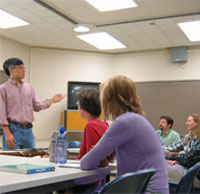International Faculty Adjusting to the US

Synopsis:
Dr. Hiroshi Kanda, after 10 years of teaching and research at Osaka University, recently took a tenured faculty position in a biomedical engineering department in the United States. He is having difficulty adjusting to the American academic culture and its students. Dr. Kanda spoke with an experienced international faculty member to better understand US academic life.
Dr. Hiroshi Kanda, after 10 years of teaching and research at Osaka University, recently took a tenured faculty position in a biomedical engineering department in the United States. He is having difficulty adjusting to the American academic culture and its students. Dr. Kanda spoke with an experienced international faculty member to better understand US academic life.
Full Story:
Dr. Kanda has been challenged by several aspects of life at his new university. His students are outspoken and informal, boldly questioning his views and expressing their thoughts on the class more directly than students he's accustomed to.
Dr. Kanda has been challenged by several aspects of life at his new university. His students are outspoken and informal, boldly questioning his views and expressing their thoughts on the class more directly than students he's accustomed to.
Strategies Menu
He must adjust to the policies and expectations of a US university. For example, he must learn the promotion process of his university. Also, the students appear poorly prepared in math and science, and he was surprised that students generally do not specialize until the third and fourth year of college.
Dr. Kanda is building his research program and has learned that National Science Foundation (NSF) proposals require explaining the broader impact of the research. He is uncertain how to effectively write grant proposals that meet all the criteria of funding agencies such as the NSF.
Professor Kanda shared his challenges with another, more experienced international faculty member in another department. His colleague explained some of the unique but possibly challenging aspects of US higher education institutions:
- American students believe that they can engage their learning in whatever way works best for them, often expecting much interaction with the instructor and in an informal manner. Students expect their relationship with faculty to be more egalitarian than authoritative. Students who appear unprepared or unmotivated may actually have conflicting demands on their time, such as jobs, extracurricular activities, or families. Understanding these students will lead to more realistic expectations.
- Higher education in the US can be different from other cultures. Engineering students may be required to take more liberal arts classes than in other countries. Tenure and promotion policies often rely extensively on research and publications, which can conflict with finding support for teaching. Navigating through the norms and policies of your university will be easier if you learn about the American academic system and build strong relationships within your own department.
- Since many funding agencies in the US have strict guidelines for the integration of research, teaching, and learning, researchers must often learn such guidelines in order to ensure continued research funding. Consider seeking help with grant writing.
Through increased understanding of the unique qualities of American higher education, Dr. Hiroshi Kanda felt more confident interacting with students and colleagues.
